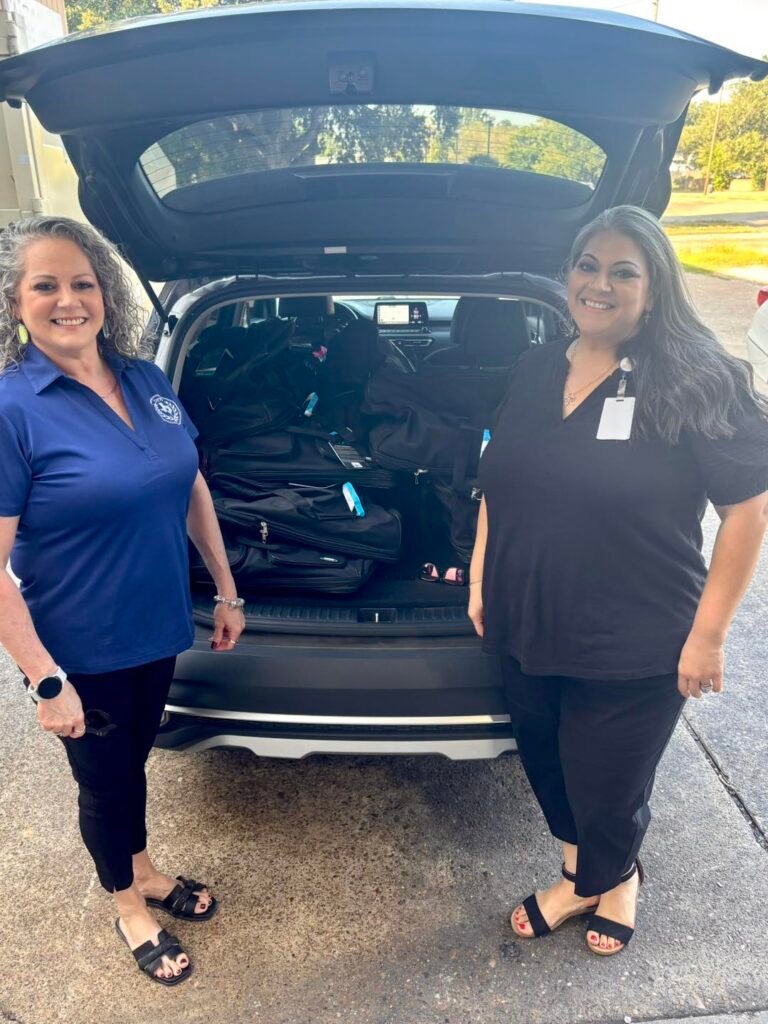Cuero Event Celebrates Native Plant Month with Tree Care Workshop
Staff Writer | September 15, 2025
In celebration of Native Plant Month, Keep Cuero Beautiful is hosting an educational event focused on the proper care of two beloved Texas trees: oaks and crepe myrtles. The workshop, titled “Proper Care of Trees: Oaks & Crepe Myrtles,” will take place on Thursday, September 18th at the Cuero Library.
🌳 Event Details
- Coffee & Networking: Begins at 9:30 a.m.
- Program Start: 10:00 a.m.
- Location: Cuero Library
- Speaker: Anthony Netardus, DeWitt County AgriLife Extension Agent
Anthony Netardus, known for his practical expertise and community engagement, will lead the session. Attendees are encouraged to bring questions, as the program aims to provide hands-on guidance for maintaining healthy trees in the South Texas climate. Whether participants are seasoned gardeners or new to native landscaping, the event promises valuable insights into seasonal care, pruning techniques, and disease prevention.
🌿 Community Engagement
Keep Cuero Beautiful continues its mission to promote environmental stewardship through accessible education and local partnerships. This tree care workshop is part of a broader effort to encourage sustainable landscaping practices and celebrate the ecological heritage of the region.
For more information, residents can contact Keep Cuero Beautiful at 361-275-2112.
Whispering Oaks Hosts Fall Harvest Festival to Celebrate Community and Autumn Joy
September 15, 2025
Cuero residents are invited to mark their calendars for a heartwarming afternoon of seasonal celebration at the upcoming Fall Harvest Festival, hosted by Whispering Oaks Rehab & Nursing. The event will take place on Friday, October 3rd from 2 PM to 4 PM at 105 Hospital Drive, bringing together families, staff, and community partners for a festive gathering filled with joy and connection.
Guests can look forward to a variety of activities including games, crafts, music, and delicious snacks, all set against a backdrop of autumn colors and community spirit. The team at Whispering Oaks has partnered with local organizations to make this year’s festival extra special, ensuring that every visitor—from young children to longtime residents—feels welcomed and celebrated.
Whether you’re a longtime Cuero local or new to the area, the Fall Harvest Festival offers a perfect opportunity to connect, celebrate, and support the mission of Whispering Oaks Rehab & Nursing. For more information, contact Krystal Galindo at 361-243-6571.
Are You Raising the Next Tyler Robinson?
What Studies Reveal About White Youth Radicalization in Conservative Households
Tyler Robinson didn’t grow up in chaos.
He wasn’t raised in poverty.
He wasn’t groomed by gangs or foreign ideologies.
He was raised in a white, conservative, Christian household—by parents who believed they were doing everything right.
His father was in law enforcement.
His family attended church.
They watched the news, voted Republican, and taught him to fear the world outside their values.
And then Tyler picked up a gun and killed Charlie Kirk—a man from his own movement. His own ideological tribe.
This wasn’t a fluke. It was a pattern. And the data backs it up.
What the Studies Say
According to the Southern Poverty Law Center’s Youth Radicalization in Focus report, young white males are increasingly radicalized in environments where exclusionary beliefs are normalized. The study found that:
- Parents and caregivers often unknowingly reinforce extremist narratives through fear-based moral teachings, political media, and religious absolutism
- Youth radicalization is rarely sudden—it’s a slow process shaped by family values, online exposure, and cultural grievance
- Online hate spaces targeting white youth are thriving, often disguised as patriotism or faith-based communities
The National Institute of Justice confirms that far-right extremism now outpaces all other forms of domestic terrorism. Since 1990, far-right extremists have committed more than 227 ideologically motivated attacks, resulting in over 520 deaths—far more than attacks from far-left or Islamist groups.
A 2024 thesis from Saint Mary’s University further explored the emotional traits of radicalized white youth, finding that feelings of isolation, entitlement, and suppressed rage were common among members of groups like the Proud Boys and America First.
The Homegrown Threat
Parents who believe their homes are immune to radicalization often overlook the slow drip of ideology:
- Sermons that preach fear instead of grace
- Cable news that turns empathy into weakness
- Dinner table rants that make difference feel like danger
- Online spaces that reward outrage and dehumanization
Tyler Robinson didn’t become a killer overnight.
He was groomed—by a culture that told him his way of life was under attack, and that violence was a righteous defense.
What Parents Must Ask
Are we raising children to be resilient—or rigid?
Are we teaching them to coexist—or to conquer?
Are we modeling empathy—or enforcing purity?
Because if we keep telling our sons that:
- Gays are ruining America
- Muslims are infiltrating
- Mexicans are invading
- Democrats are evil
- Empathy is weakness
Then we shouldn’t be surprised when they crack.
When they pick up a gun.
When they become the next Tyler Robinson.
The Real Question
Are you raising your child to live in the world as it is—or to destroy it because it doesn’t match the script?
Until we confront that question, we’re not just failing our kids.
We’re building the next tragedy.
SOURCES:
Key Statistics on Domestic Terrorism & White Nationalist Violence
- Far-right extremists have committed far more ideologically motivated homicides than far-left or radical Islamist extremists since 1990. One study counted 227 far-right attacks resulting in over 520 deaths, compared to 42 far-left attacks causing 78 deaths.
- From 2001 to 2016, there were 85 deadly attacks by violent extremists in the U.S. Most were carried out by far-right actors, though attacks linked to jihadist extremists caused more deaths overall due to events like 9/11.
- The National Institute of Justice found that militant white supremacist extremism has outpaced all other forms of domestic terrorism in recent years. Their research highlights how radicalization is often fueled by online communities, ideological grievances, and perceived threats to identity.
- Prior to 2017, white nationalist groups were being actively monitored by federal agencies. The FBI and DHS had issued multiple warnings about the growing threat of far-right extremism.
- But once Trump took office, resources and attention shifted. Programs focused on countering violent extremism were restructured or defunded, and official rhetoric often downplayed the threat of white nationalist violence—even after events like Charlottesville.
- A 2020 thesis from Johns Hopkins argued that the U.S. lacks a coherent strategy to combat domestic terrorism, especially white nationalist violence. It called for federal legislation to criminalize domestic terrorism and address systemic failures in counterterrorism policy.
- Lone Wolf Report: SPLC’s 2015 study found that 74% of domestic terror incidents between 2009–2015 were carried out by lone actors or small cells—making them harder to detect and disrupt. The report warned that domestic terrorism was being overshadowed by the focus on foreign jihadist threats. (*And now on our focus on the border and ICE raids)
- Presidential Transition Priorities (2020): SPLC flagged that white supremacist extremists were responsible for the majority of domestic terror deaths in 2019, the deadliest year since the Oklahoma City bombing. They urged the federal government to confront the mainstreaming of white nationalism and dismantle institutions that reflect white supremacist ideology.
- Annual Hate & Extremism Reports: SPLC tracks hate groups, including white nationalist, neo-Nazi, and anti-government militias. Their recent reports show a surge in far-right organizing, disinformation campaigns, and threats to election workers.
Psychology Studies on Radicalization & Extremism
Here are three standout studies that dig into the psychological roots of extremist behavior:
- Rational Emotive Behavioral Conceptualization
- Radicalization involves irrational beliefs, absolutist demands for fairness, and intolerance of uncertainty.
- Extremist ideologies often appeal to individuals seeking control or significance in chaotic environments.
- Full study PDF
- Significance Quest Theory (Kruglanski et al.)
- Radicalization is driven by a deep need for personal significance.
- Violence becomes justified when it’s framed as a path to meaning or group belonging.
- Social networks and ideological echo chambers reinforce this process.
- Full study PDF
- Social-Developmental Model of Radicalization (Beelmann, 2020)
- Early life adversity, authoritarian personality traits, and exposure to group discrimination increase susceptibility.
- Radicalization unfolds in three stages: developmental risk, ideological adoption, and behavioral action.
- Intervention is most effective between ages 8–12, when prejudice and identity formation begin.
- Psychology Today summary
By: Concerned Citizen
Editor’s Note from Cuero Online News:
This article was submitted by a contributor who requested anonymity. The author identifies as a concerned citizen and chose not to disclose their name publicly, citing personal safety and the sensitive nature of the topic. Cuero Online News respects this decision and has verified the submission in accordance with our editorial standards.
Honoring a Legacy: The Kay Reese Memorial Scholarship Continues to Inspire Cuero Students
Staff Writer | Sept 14, 2025
In the heart of Cuero, Texas, the Kay Reese Memorial Scholarship stands as a living tribute to the remarkable life of Cherie Kay Holloway Reese—a woman whose faith, family values, and unwavering dedication to education shaped generations.
A proud alumna of Cuero High School, Mrs. Reese devoted her life to nurturing young minds both in the classroom and in the community. Her advocacy helped secure the bond issue that led to the construction of John C. French and Hunt Elementary schools, a testament to her belief that education is the foundation of a thriving society.
Established in 2005 by the Reese family, the scholarship is administered by the Cuero ISD Education Foundation and awarded to students who exemplify academic excellence, community commitment, and strong moral character—values Mrs. Reese lived by. Past recipients include Madison Fink, Amy Williams, Jake Payne, and Brady Watson, each continuing her legacy in their own way.
The Foundation encourages all eligible seniors to apply. Application forms for all scholarships are available online, and Cuero High School counselors will host a senior meeting in late January to guide students through the process. The Education Foundation will provide detailed information and support to ensure every student has the opportunity to pursue their dreams.
As Cuero continues to honor Mrs. Reese’s legacy, the scholarship remains a beacon of hope and opportunity—reminding us that one life, rooted in service and love, can uplift an entire community.
Knights of Columbus in Cuero Honor Pope Leo XIV on His 70th Birthday
Sept 14, 2025
This week, the Knights of Columbus in Cuero, Texas joined Catholics around the world in celebrating the 70th birthday of His Holiness, Pope Leo XIV. In a spirit of gratitude and prayer, local Knights offered thanks for the pope’s unwavering leadership, his witness to the Gospel, and his fatherly care for the global Church.
The Cuero council—part of the Catholic community serving Cuero, Meyersville, and Westhoff—has long upheld the values of faith, charity, and fraternity. On this special occasion, members gathered in quiet reflection, lifting prayers for the Holy Father’s health, strength, and continued guidance by the Holy Spirit.
“St. Peter, pray for him. Mary, Mother of the Church, intercede for him,” read a message shared by the Knights, echoing the deep reverence felt across DeWitt County.
Though the celebration was global, the sentiment was deeply local. In small towns like Cuero, where faith and fellowship remain cornerstones of community life, the pope’s birthday is more than a milestone—it’s a reminder of the spiritual ties that bind believers across borders and generations.
To learn more about the Knights of Columbus in Cuero or to get involved in their charitable work, visit Catholic Cuero’s Knights of Columbus page.
Lady Bulldogs Set to Face Tidehaven in Home Court Showdown
Staff Writer | Sept 14, 2025
Yoakum High School is gearing up for a high-energy volleyball matchup as the Lady Bulldogs prepare to host Tidehaven on Tuesday, September 16, 2025. The game will take place at the Yoakum High School Gymnasium, with the first serve scheduled for 6:00 p.m. in what promises to be a pivotal conference clash.
Both teams enter the match with fresh momentum and a hunger to prove themselves early in the season. For Yoakum, this home game is more than just a contest—it’s a chance to showcase grit, teamwork, and the pride that defines Bulldog athletics.
Community members are encouraged to pack the stands and show their support. Whether you’re a longtime fan or a first-time spectator, your cheers matter. The Lady Bulldogs have been training hard, and the energy from the crowd could be the edge they need.
So, grab your gear, wear your blue and white, and head to the gym. Let’s make it loud, let’s make it proud—Yoakum Proud.
Suitcases, Not Trash Bags: Local Effort Brings Dignity to Children in Foster Care
Sept 14, 2025 | Cuero, Tx
In a quiet but powerful gesture of compassion, Pain to Purpose, a community-driven initiative, delivered a set of suitcases and essential toiletries to Cuero Child Protective Services (CPS) this week. The donation is part of a broader mission to replace the all-too-common image of foster children arriving at new placements with their belongings stuffed into trash bags—a symbol of neglect that advocates are determined to erase.
Accepting the donation were Janell and Katherine, representatives of Cuero CPS, who stood beside the open trunk of a car filled with neatly packed suitcases. The moment, captured in a photo shared by Friends of DeWitt County Children, reflects a growing movement to restore dignity and care to some of the most vulnerable members of the community.
Pain to Purpose has been working tirelessly to ensure that children entering foster care are met not just with basic necessities, but with a message: You matter. You are seen. You deserve better.
Supporters are encouraged to visit Pain to Purpose’s social media pages to learn more about their mission and how to contribute. Whether through donations, volunteer work, or simply spreading the word, every effort helps rewrite the story for children who deserve more than a trash bag—they deserve a future packed with hope.
Cuero Gobblers Dominate Yoakum in Historic Rivalry Clash, 42–28
CUERO, TX — September 12, 2025
The Cuero Gobblers delivered a statement win Friday night, overpowering the Yoakum Bulldogs 42–28 in the 116th installment of their historic rivalry. With a balanced attack and relentless tempo, Cuero extended its undefeated season to 3–0 and reaffirmed its place atop the district conversation.
Quarterback Jaxxon Marie set the tone early, slicing through Yoakum’s defense with a mix of precision passing and explosive runs. Cuero’s offensive line controlled the trenches, allowing the Gobblers to dictate pace and possession throughout the night.
Yoakum kept it close through two quarters, but Cuero’s second-half adjustments—particularly on defense—shut down the Bulldogs’ momentum. The Gobblers held Yoakum scoreless in the fourth quarter, while tacking on two touchdowns to seal the win.
The victory not only extends Cuero’s win streak to six games dating back to last season, but also marks their third consecutive win over Yoakum. With district play looming, the Gobblers look sharper, deeper, and more disciplined than they did this time last year.

Next up: Cuero travels to face Miller on September 20. If Friday’s performance is any indication, the Gobblers aren’t just chasing wins—they’re building a legacy.

Game Stats Summary
- Final Score: Cuero 42, Yoakum 28
- Jaxxon Marie (QB):
- 12 carries, 141 rushing yards, 2 rushing TDs
- 195 passing yards, 2 passing TDs, 71.4% completion
- Team Rushing Total: 260 yards
- Cuero Defense: Held Yoakum scoreless in the 4th quarter
- Yoakum Record: Falls to 2–1
- Cuero Record: Improves to 3– 0
Ralph Henry Dickinson – October 13, 1944 to September 11, 2025 (80)
YOAKUM: Ralph Henry Dickinson, age 80, passed away Thursday, September 11, 2025. He was born October 13, 1944 in Yoakum to the late Eugene Edgar Dickinson and Leona Marie (Porch) Dickinson.
Ralph was a working man with a determined attitude and work ethic. He graduated from Yoakum High School with Honors and went to the University of Houston, graduating in 1973 with Honors to become a pharmacist for the next 52 years. He worked for many years in Victoria and then Schulenburg, continuing to work until 3 weeks before his death. He loved his job and enjoyed helping people.
Survivors are his wife of 60 years, Katherine (Kuenstler) Dickinson and nephew, Matt Dickinson and wife Debbie.
He is preceded in death by his parents, Eugene and Leona Dickinson and brother, Gene Dickinson.
Visitation 4 to 6 p.m., Sunday, September 14, 2025 at Thiele-Cooper Funeral Home in Yoakum.
Funeral Service 3 p.m., Monday, September 15, 2025 at Thiele-Cooper Funeral Home with Pastor H.E. Fowler, his friend and fellow pharmacist and Fr. Tim Kosler officiating. Burial to follow at St. Joseph Catholic Cemetery.
Pallbearers are Kenny Holik, Doug Shows, Wesley DeBord, Lynn Kuenstler, Chase Holik, David Kuenstler, Trey Kuenstler, and Matt Dickinson.
Honorary pallbearer is Kyle Holik.
Memorials may be given to County Line Cemetery Association.











